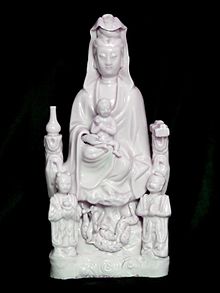Maria Kannon
As Maria Kannon ( Jap. マリア観音 ) refers to the early 17th century in Japan. Arisen statues of Buddhist deity Kannon , which by local crypto Christians ( Kakure Kirishitan ( 隠れキリシタン , kakure kirishitan )) to worship the Virgin Mary have been used.
The Christian mission in Japan began in 1549 with the landing of the Jesuit Francisco de Xavier , which achieved some success during the first decades, but was subjected to increasingly severe oppression after Toyotomi Hideyoshi issued the first anti-Christian edict (1587) and finally in 1639 with the Expulsion of the remaining missionaries and the ban on Christianity collapsed. Those who wanted to survive among the native Christians had to find ways of practicing their faith that did not arouse suspicion on the part of the authorities or possible informers.
Especially in the west and north-west of Kyūshū , where the Kakure Kirishitan were able to hold out until the country opened in the 19th century, figures of the deity Kannon (Sanskr. Avalokitêśvara, Chinese 觀音 , Pinyin Guanyin ) were used instead of the European Marian figures . Iconographically, there were a number of similarities that served as camouflage. The bodhisattva Avalokitêśvara had taken on feminine traits in China and was worshiped in three forms in Japanese Buddhism , which were closely related to birth and motherhood: Juntei Kannon ( 准 胝 観 音 ), Koyasu Kannon ( 子 安 観 音 ), and Jibo Kannon ( 慈母 観 音 ). The latter two were used for the veneration of Mary. Occasionally figures of the Buddhist deity Kishimojin ( 鬼子母 神 , Sanskrit Hārītī ) were used. She usually holds a child in her arms and a pomegranate in the other hand as a symbol of fertility.
In addition to porcelain figures imported from China, figures made of ceramic or wood made in the country also spread. Often hidden cross shapes can be found here, be it as a diadem in a headdress, be it as a pendant on the neck or in other accessories. Especially among the crypto Christians in the Nagasaki / Hirado area and on the Goto Islands , these figures were used until the Christian ban was lifted in 1873.
literature
- Chün-fang Yü: Kuan-yin, The Chinese Transformation of Avalokitesvara , Columbia University Press 2001, ISBN 0-231-12029-X
- Reis-Habito, Maria: Maria Kannon: The Mother of God in Buddhist robe . In: Comparative Philosophy of the Present. Hisaki Hashi / Werner Gabriel (eds.), Vienna, 2007, p. 13ff.
- Turnbull, Stephen R .: The Kakure Kirishitan of Japan: a study of their development, beliefs and rituals to the present day . Richmond, Surrey: Japan Library, 1998.
Remarks
- ↑ Called Cundī in Sanskrit, this deity was found in China as the “Bodhisattva of Extreme Purity” ( Chinese 準 提 菩薩 , Pinyin Zhǔntí Púsà ) or “Buddha Mother of Extreme Purity” ( Chinese 准 胝 観 音 , Pinyin Zhǔntí Fómǔ ), especially in esoteric Buddhism great spread. She is usually depicted with eighteen arms.
- ↑ This deity has its roots in the mythological princess Konohana-sakuya-hime ( 木花 之 佐 久 夜 毘 売 ), a Shinto deity also known as Koyasu-sama ( Sh 安 様 ) , who was asked for safe and easy births ( koyasu ) . Also widely used in the form of Koyasu Jizō ( 子 安 地 蔵 ), a protective bodhisattva with "male" features.
- ↑ This deity appeared in the 14./15. Century in China as "child- giving Kannon" ( Chinese 送子 観 音 , Pinyin Sòngzǐ Guānyīn ), but found its way to Japan only in the early 17th century.
- ↑ According to the old calendar, the festival of the Kishimojin in Sendai took place on the fifteenth day of the eighth month ( Assumption of Mary ). In front of the statue there were dining trays with twelve pairs of chopsticks.

